What You Need to Know Before Buying a Project Car
Have you always wanted to restore a beautiful old car or a modern classic to its former glory? It's certainly one on a few bucket lists out there, so if you’re getting closer to making this a reality, we have noted a few things you should keep in mind as you start your journey.
Set Your Budget
Figure out what you’re prepared to spend on your project. Here we are referring to a project car rather than a car that is already in perfect condition. When looking at cars and considering what needs to be done in each case you will need to divide the work into tasks you can do yourself and tasks you will need an expert to complete. You may need to research costs for each type of work required when deciding on your budget. Don’t forget, as well as the restoration costs you will need to keep in mind on-road costs, engineering reports, certification and once on the road you’ll need to factor in insurance costs.
Having a good idea of the costs upfront you will be able to buy a car that you can restore within budget and be less likely to have to abandon the project before it is complete.
Start The Hunt
Probably the most difficult part of the process is finding the right car. You don’t want to rush into this. Too often people are impatient and buy one of the first vehicles they find. You want to avoid this by all means necessary. Unless of course you come across a gem early in your search. Choosing the right vehicle will not only save you time but will also ensure you don’t blow your budget.
Don’t “fall in love.” If you find a car you really like, you will likely start looking through rose-tinted glasses. You will see all the good parts, and neglect to see the bad. Be sure to step back and take the time to find any red flags.
Having said that you may find a bargain in really great condition that will mean you don’t have to sink all that money into restoration.
Like most things, if it’s out there to buy it will usually be online somewhere. New Zealand has some excellent local directories. Trademe alone currently has around 800 classic vehicles looking for someone to love them. If you're in Wellington it would certainly be worth taking a trip to the Kapiti Coast and visiting Auto Classics. They always have an excellent selection of classic vehicles.
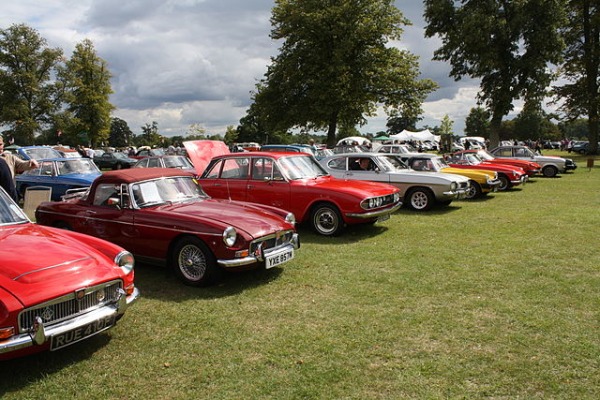
There are many enthusiast groups on social media platforms such as Facebook where vehicles and parts are offered for sale or swap. These may be local or national groups. If you find a likely car you may need to travel. Some of these groups are specific to a single model or manufacturer, others welcome a range of vehicles and run competition events. Even if a car is not advertised directly, they can be a good source of leads for rarer vehicles or parts.
With rarer vehicles you may need to buy the vehicle as a set of parts you collect over time from different sources and reassemble. While searching keep a note of donor vehicles. These are vehicles that can be purchased for use as a source of body or mechanical parts and is usually a cost-effective way of getting the parts and spares you need for the vehicle you are restoring.
Because of the rising cost of scrap metal and car scrappage schemes over the past few years there are less collections of older vehicles able to be restored waiting in fields and scrap yards than there used to be. Environmental rules mean that individuals can no longer store collections of vehicles on their properties. These days potentially restorable vehicles end up being bought by companies that are more interested in breaking them up for scrap metal or parts. They will advertise car removal services offering $300 for any vehicle. Parts companies will not usually sell you an entire vehicle as dismantlers were happy to in the past.
The passage of time means many older vehicles are now no longer in a condition where they can be restored unless they are valuable. You will still pay a premium for a pile of rust with the chassis tag attached if the car is a valuable collectable.
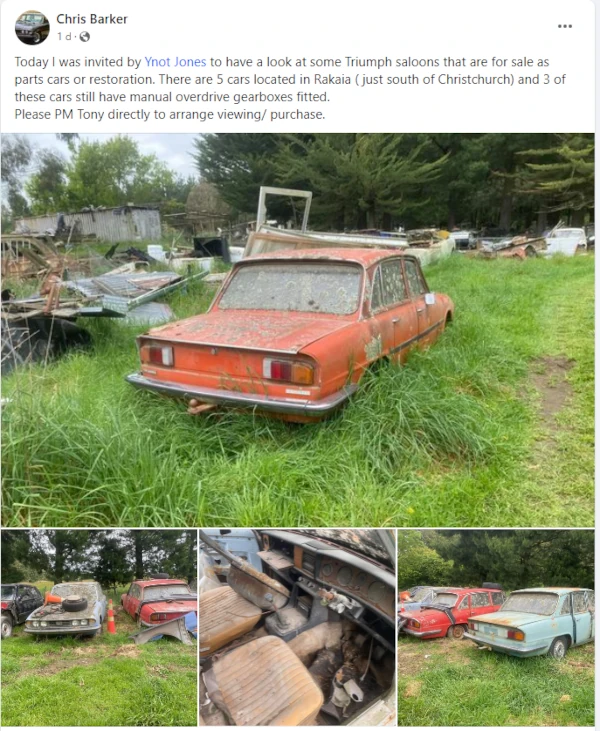
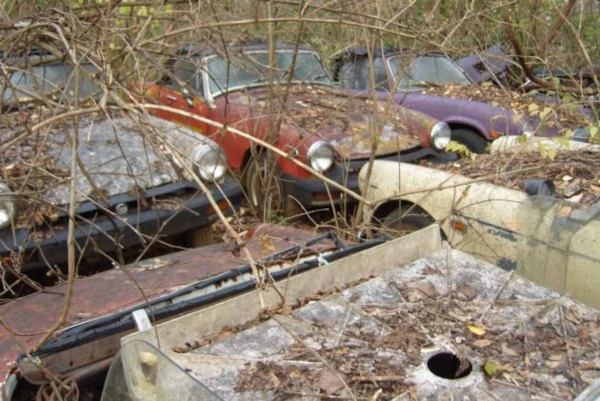
Modern Classics?
You may want to consider buying a modern classic or a vehicle which may become one. This has several advantages:
- There are more examples of the vehicle available
- Parts, both new and used may be easier to source
- Car clubs and groups may be supported by the manufacturer
You can place ads in the local paper or social media groups yourself offering to buy vehicles. These vehicles may be a good source of parts or a donor vehicle if they are not good enough for restoration.
Another source for these vehicles are auctions. These will more commonly be late model vehicles, but older vehicles sometimes show up as a result of deceased estate sales for example. They commonly fall into two groups.
- Standard Auctions – Vehicles are sold as road worthy with warrant of fitness and registration. There may be some work required on the vehicle and the price reflects the demand for that vehicle. Vehicles may sometime be passed in if they don’t meet the reserve price and you may be able to negotiate with the owner.
- Damaged or End of life auctions – These auctions comprise high mileage vehicles that may be trade ins from car dealers, private owners, cars with potential defects or damage and cars from car removal companies where they may make more money selling the car as a whole. They are also placed by insurance companies due to physical or mechanical damage. These vehicles in most cases are sold de registered, but this is not always the case. Turners End Of Life Auctions
Because of the complexity of modern electronic systems in cars always try and buy a car with the electronic key. This is also important if buying a car at auction for parts such as the engine, as modern immobilisers can prevent ECUs (Electronic Control Units) from working. These keys can be expensive to replace or have recoded.
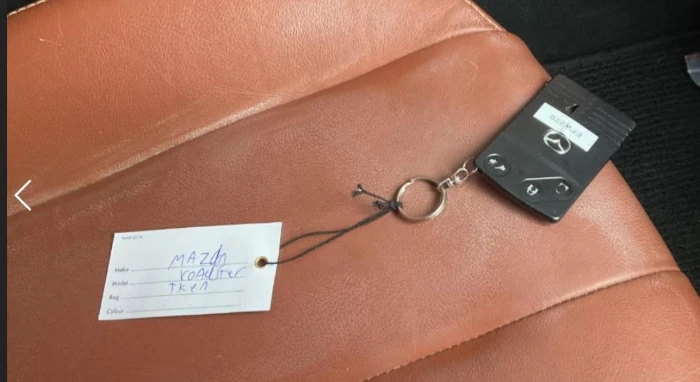
Vehicles in these auctions can range from old classics to late model performance vehicles.
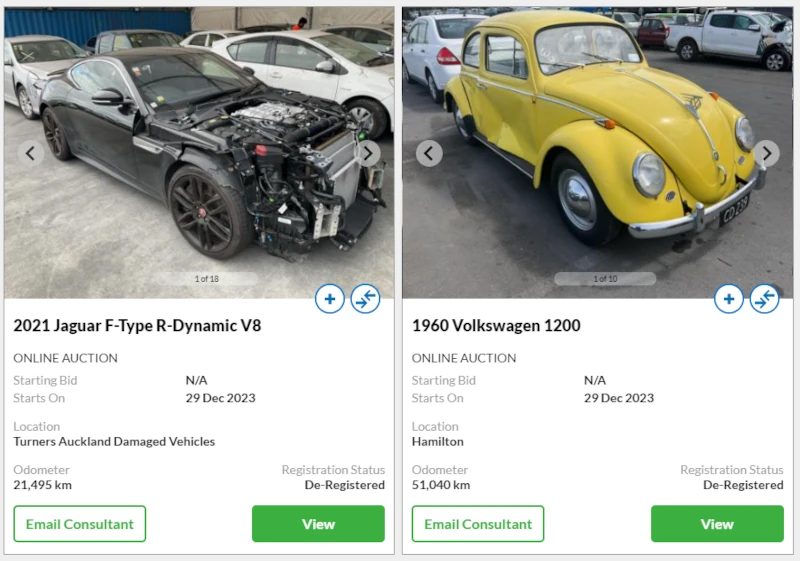
Be very careful buying any vehicle which is deregistered or has never been registered in New Zealand. Insurance companies are required to deregister certain vehicles to prevent their identities being used to conceal stolen vehicles or allow poorly repaired damaged vehicles back onto the road. Any vehicle which has a registration lapse for more than 12 months will be cancelled and will need to get a new regstration. The owner may have deregistered the vehicle if they haven’t used it for some time. Owners can also place the registration on hold which can be renewed for as long as required. These vehicles with rego on hold can simply be re-registered and put back on the road if they have not been modified (see vehicle certification).
Water damaged vehicles – vehicles which have been deregistered and removed from the road due to water damage are not worth the effort even if they look great. It is often not possible to see corrosion caused by the water without dismantling the vehicle for inspection. Engines can suffer serious damage if they ingest water when running. Modern vehicles have stringent requirements to have wiring and electronic safety devices completely replaced before being allowed back on the road. Only consider a water damaged vehicle as suitable for spare mechanical parts, glass or panels. Auctions in New Zealand must disclose if a vehicle has water damage. If looking overseas this may not be the case.
Don’t be discouraged though, there are many valid reasons for a vehicle to be deregistered. If you can, speak to the current or previous owner to see why the vehicle was de-registered.
Never Registered Vehicles
These are vehicles which have never been on the road in New Zealand. They fall into several categories:
- Imported for use as a competition vehicle, never to be used on the road
- Parts donor vehicles
- Vehicles which have been imported to be complied for use on the road and can then be registered
It is important to understand that some vehicles cannot be complied. These are mainly later model vehicles made after a certain date which do not meet current safety, crash test or emission standards. Additionally, a particular model of vehicle may not meet standards until after a certain date, generally identified by chassis number, after which changes to the design allowed the model to comply. A vehicle for use on the road must not have any crash or corrosion damage. NZTA publishes lists of vehicles by manufacturer showing which ones a not compliable and which ones can be complied after specific dates or model changes. Check the following links for information.
If you are importing a vehicle or are thinking about purchasing an uncompiled vehicle first consult the NZTA website to ensure that the vehicle meets the appropriate standards. Vehicles older than 20 years are regarded as enthusiast vehicles and may be able to be complied under the low volume scheme. Again if you do not know check first!
While it is possible in rare or specialized cases to import a damaged or incomplete vehicle and have it complied, it is generally easier to import a complete vehicle for restoration. In all cases, you should consult specialist vehicle compliance experts before proceeding.
If the vehicle is damaged or rust you may need to repair the vehicle and have the repairs certified.
Purchasing a Vehicle From Overseas
The best way to approach buying a vehicle from overseas is to do it in person. However, you may not have the time or money to do this. There are many reputable online auction sites or sites specializing in international vehicle sales. Ther are also companies that will act as an intermediary for you and arrange documentation and shipping for a commission.
Auctions - ie Japanese Auctions:
If possible look for vehicles that are from drier areas for example Australia, Southern Europe, Arizona, Nevada that don’t have corrosive chemicals such as salt, spread on the road in winter. Vehicles from drier areas may have more sun damage and fading, so it can be a compromise. Check the rules for importing and registering left hand drive vehicles if that is what you are considering.
Deregistration Papers.
In order to register an imported vehicle in New Zealand you must provide proof that you own the vehicle and have come by it legitimately. This will generally mean proving that the vehicle was deregistered before export and/or an export document has been issued. In Japan this is known as an export certificate or a deregistration certificate. There is also a similar document available from Europe and other countries. You should also be prepared to produce a bill of sale and a registration record for the vehicle. That documentation may also be acceptable if you do not have deregistration certificate. Generally, always request a deregistration certificate or equivalent where possible to make things easier and prove the vehicle is not stolen.
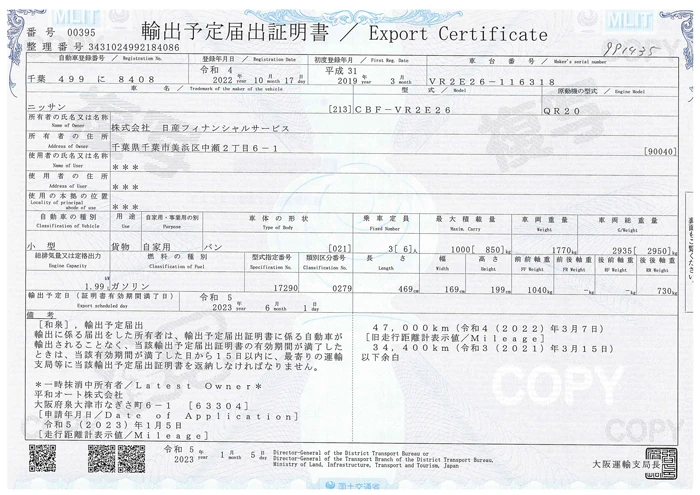
The following page lists the requirements for importing a vehicle from Europe.
General Information
Before Importing A Vehicle
Entry certifiers assess whether or not vehicles meet the applicable standards and can be registered for use on the road. Talk to an entry certifier early in the importing process to get their advice on your vehicle's suitability. If your vehicle doesn’t meet the standards on arrival, it may be too late to do anything about it. If your vehicle does not comply and meets the criteria, it may be regarded as a ‘special interest’ vehicle on be eligible for certification under the low volume scheme. Additionally, vehicles over 20 years old may not need to meet the full set of requirements for newer vehicles depending on the rules in force when they were manufactured.
Older vehicles that have previously been registered in New Zealand need only to meet the requirements in force at that time for that vehicle to be re-registered. You will need to have proof of previous registration and proof of current ownership.
If you wish to purchase this vehicle for use upon New Zealand roads, you will need to have the vehicle re-registered (new plates assigned), obtain a current WOF or COF, possibly have a VIN assigned, and purchase a current vehicle licence.
As part of the re-registration process, the vehicle will undergo a thorough safety inspection for frame damage etc. This inspection costs approximately $450.
You may also be responsible for paying overdue/unpaid license or RUC fees if applicable to this vehicle.
Notes On Vehicle Licensing
Car Licensing And Registration
Importing Older Vehicles
Once a vehicle is of a certain age it may qualify for import.
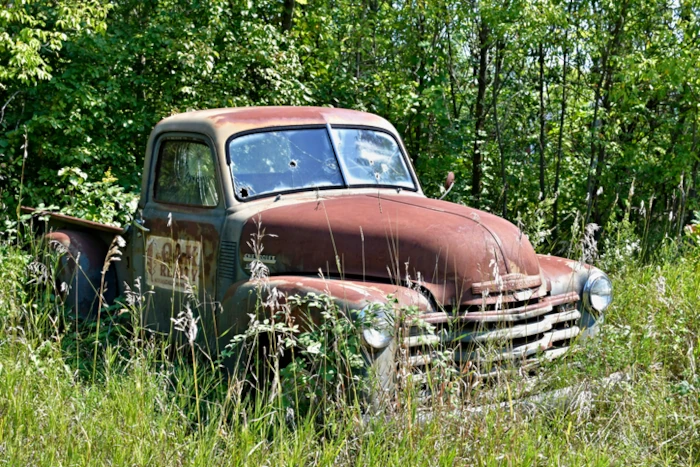
De-registered Or Modified Vehicles
As mentioned, if the vehicles registration has lapsed unless the vehicle has been damaged or modified it can simply go through the normal WOF and registration process. If your vehicle was deregistered it must go through a recertification process. This process is longer, but similar if you are putting a modified or damaged vehicle on the road.
If the vehicle is modified, modifications outside of certain criteria will need to go through the Low Volume Certification process. This process can also be used for vehicles over 20 years of age where the vehicle may be regarded as a specialist vehicle.
Low Volume Certification Process
It is best to start this process at the beginning of your project as you may discover additional requirements you were not aware of. This is why it is important to consult a bodywork repair specialist if you are considering purchasing a damaged or deteriorated vehicle for restoration unless you are experienced and can do the job yourself. They may be able to check out the vehicle before purchase. They will be experienced with repairing vehicles to the standard required to pass the certification process. Additionally, they will be able to identify any previous repair work on the vehicle that may either need to be redone or may render the vehicle uncertifiable. They may either inspect a potential purchase themselves for a fee or recommend someone who can.
Repairing Vehicles
Modern vehicles incorporate a lot of features designed to enhance safety and the longevity of the vehicle. For example, the following vehicle – the MX5, selling at auction is constructed from both mild steel and high tension steel. This is to create crumple zones during an impact to dissipate energy that would otherwise affect the occupants in a crash. An expert would check to see if the damage is limited to areas of mild steel which can be straightened or also effects high tension steel which cannot. Components made from high tension steel will need to be replaced if deformed as they cannot be stretched or heated. These will usually be chassis rails or structural members.
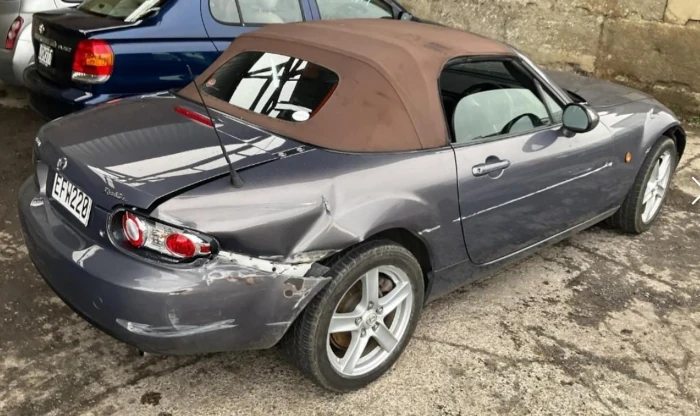
It is easier to get a vehicle certified if you can provide manufacturers manuals showing the way the vehicle is constructed, assembled and repaired. This is usually known as the body shop manual and shows the location of high strength steel and other materials.
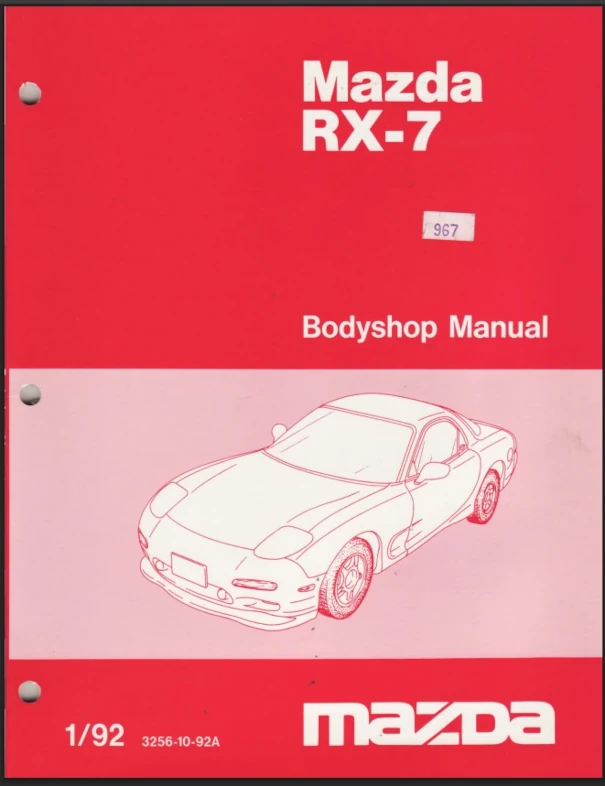
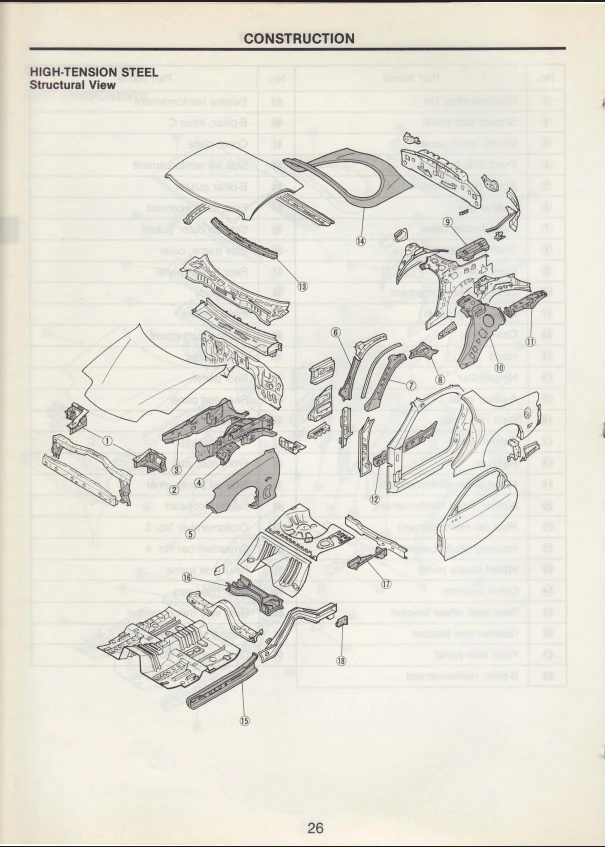
It also shows where things like cuts to structural members, spot welds, seam welds and body sealer need to be applied. Repairs need to match these specifications.
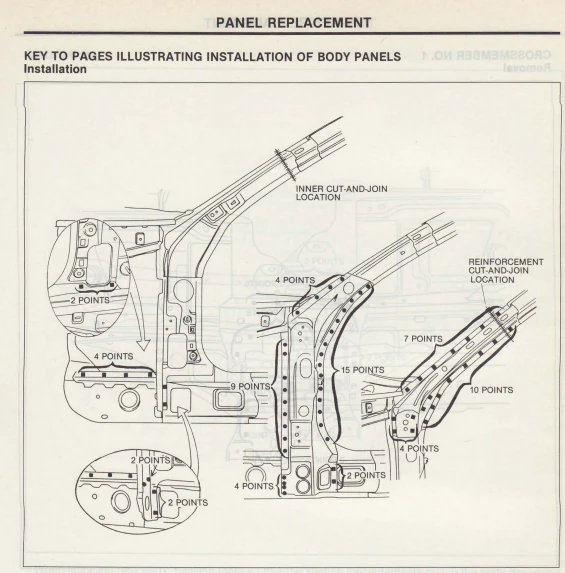
You should check availability of parts once you have determined what needs to be repaired, ideally before you purchase the car. It is also possible to use panels from donor vehicles if you use the body shop manual to disassemble them in the same way they were assembled. You can build this knowledge up more easily over time if you are looking for a particular make of car. Don’t rush in and buy the first example you find. There may be a reason it is not selling at auction.
Before you head to your first inspection…buy a log book
There’s a lot to check when you’re look at each of your potential projects. You’ll want to take note of every little detail and be able to go and budget all the potential repair work. You can keep track of all the vehicles you are looking at and start to weigh up the pros and cons. If a deal falls through you will have all the information you need to look at alternatives.
Buying Normal Vehicles
Don’t assume that just because a vehicle is being presented as being in good condition that, that is the case. There are plenty of cars quickly repaired and put up for sale. Apply the same level of due diligence when buying a warranted and registered vehicle.
Check The Bodywork
Be meticulous. You’ll find plenty of rusty old cars up for sale. The reason for this, is that bodywork can easily become the most expensive part of your restoration. We have a few floating around our vehicle storage units. It is usually easier to fix a mechanical issue than effectively treat rust once it has started. Welding is hugely expensive if you cant do it yourself, so it needs to be avoided like the plague. Familiarise yourself with a few simple tricks to check for a warped chassis., this can be a sign of accident damage or poor repair and simply requires a few minutes with a tape measure.
- You want a solid foundation to build on. Everything else is an easy fix in comparison.
- You must check underneath the car. Even if it means crawling on the ground.
- Check for bubbling under the paintwork. This is generally a sure sign of danger below.
- Take note of any panels with visible rot, and get quotes for repairs on these.
- Be aware of dodgy fix jobs. Some crafty buggers will use some sort of filler on rotting bodywork and give it a fresh coat of paint. If a panel if looking a little shinier than the rest, be sure to ask what’s been done under that section.
- Take a magnet with you, perhaps wrapped in fabric and with permission check for rust in the places that type of car rusts. This information is easy to find online and most models have well known trouble spots. Note – This will not work with Aluminum panels or composites.
Next Stop… The Engine
So, you pop the hood. How’s it looking? Is the wiring looking pretty tidy? If it’s been taped up, not the end of the world. If it looks untidy with different types or colours of tapes or with loose wires, you’ve got yourself a red flag.
How’s the oil looking? If it’s a bit milky, there’s a chance there are issues with the head gasket. Make sure to check the temperature on the test drive. Ensure the test drive is long enough to reveal any problems.
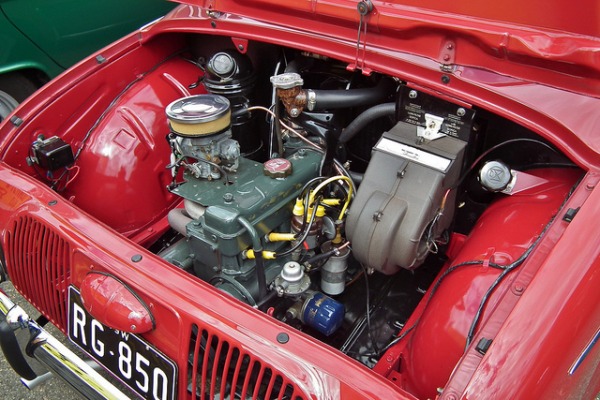
Once you’ve given the engine a once over, it’s time to start her up and listen to her sweet voice. You’ll want to make sure the engine is cold first, otherwise some issues will not show up. Ask about maintenance and ask to see any receipts for work on the vehicle.
Were there any significant fumes when you started up? Hopefully she’s rev’ing with no misfiring, or delays. Be aware that the Italian tune up does not usually work with newer vehicles!
If the engines a dud, it’s something to add to the budget. Do your research before looking for a certain model of car. Check on the availability of spares. Sometimes older models have parts available from the manufacturer and may be better supported than newer models. In some cases, third party companies make new parts. Also consider that the same parts may be used across a range of models. The same engine or other parts may have been used in sports models, family cars and trucks. Parts on other models may be less expensive and easily adapted to your vehicle type. This may simply involve attaching a bracket the other way around.
Check The Numbers Add Up
I’m not talking budget this time. If you’re looking for a genuine classic vehicle as an investment you want to check that the rear axle, transmission, and engine all match the car’s VIN number. In some cases the VIN will indicate the trim level and accessories the car left the factory with. There may also be an option plate with this information. Enthusiast groups or publications will list information that will allow you to decode these numbers. Different colours and trim levels may indicate the car is not genuine.
For example, this is the plate from a Plymouth Cuda 1970 2 Door Hard top with 383 cubic inch V8 and a heavy duty automatic transmission. There may be a valid reasons for parts having been replaced over the years. For example, replacing an automatic transmission with a manual.
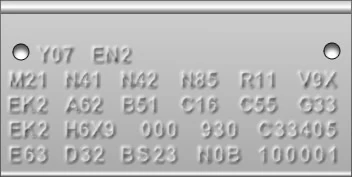
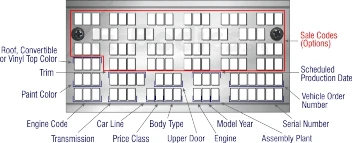
Get Her On The Road
If the car has started up, you will want to take her for a test drive. This is the only way to find out what else is potentially wrong. www.consumerprotection.govt.nz has a good basic checklist you can download about taking a vehicle for a test drive. Check if the steering wheel is offset from centre or the car wanders if at the centre point. If this is the case perhaps ask for a wheel alignment and check the chassis dimensions if the steering is still off afterwards. This can indicate a distorted chassis due to damage or poor repair. This may not be the end of the world as you may be able to negotiate a better price and fix the damage later.
Don’t Be Scared Of High Mileage
This is a project after all. As long as it’s been well maintained you should be ok. The lower the mileage, the higher the purchase price. If the vehicle was fleet vehicle the maintenance is likely to have been done regularly and on time. Again, ask for the cars history. With electric vehicles consider the remaining battery mileage on full charge. Third party battery repair shops can swap in cells and repair batteries. Car manufacturers generally recommend replacing the entire battery. Projects featuring electric vehicles are likely to become more common. Please note we do not allow battery packs to be stored in our storage facilities.
Size Should Be Considered
You’ll want to be sure you have adequate space to store your car, both while you’re working on it, and when it’s just parked up. Whether you’re parking it at home, or have looked into vehicle storage units, be sure to measure everything up to make sure you don’t get left in a tight spot. In most cases you can only use vehicle storage for parking the vehicle. Some vehicle storage facilities do allow you to do varying levels of work on your vehicle, these will often advertise workshop storage services. If you cannot store you vehicle inside at home and are concerned it may be damaged or stolen, vehicle storage is a great option.
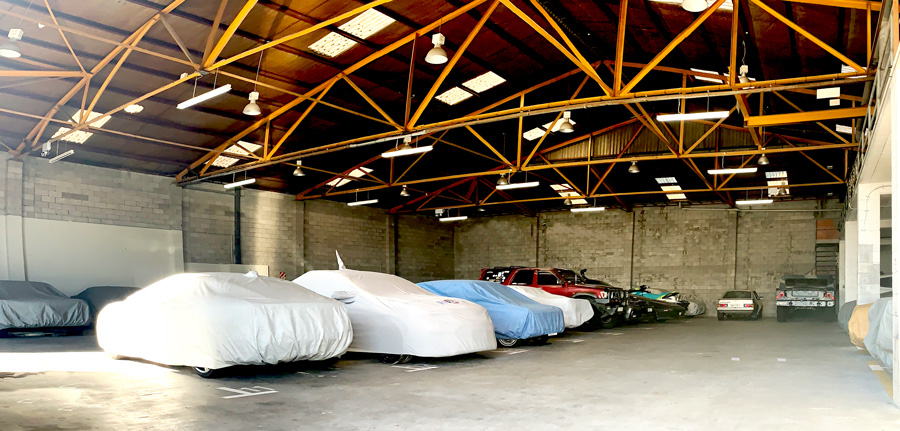
Consider renting a storage unit to store parts while you are putting the project together or to clear space to work on the project when it all starts to come together. You can organize your carefully labelled parts more easily if you don't have to work around them or move them all the time.
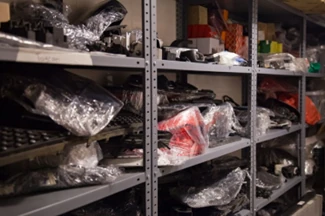
Self storage is a great option for storing parts for one or more projects. It frees up space in your work area and makes sure potentially rare parts are not damaged while you are working on the car. Make sure parts going into storage are carefully packaged and labelled to ensure they stay in top condition. You can upsize or downsize your storage space as the project progresses. Also consider sharing space with friends who also need space for their projects.
Do Some Good Old-fashioned Haggling
This doesn’t come naturally to a few of us Kiwis, but it’s pretty easy once you get the hang of it. Throw a few compliments out about the car, and offer a low figure, all with a smile. Don’t expect to get a final figure right away. Go back and forth until you’re 10-15% away from asking price. Once there give your final offer and be prepared to walk away. Remember to leave your contact details so the seller can contact you later to continue the negotiation.
Buy Good Quality Tools
Don’t be tempted to save money by purchasing cheaper low-quality tools. You’ll end up having to replace them sooner rather than later, and there’s nothing worse than really getting into the rhythm of your project late at night to have something like a cracked socket wrench put a halt to everything. If you are taking on new skills such as welding or panel work it is easier to buy the proper tools so you do not have to rush to get rented tools back on time. You can always sell things like Tig welders and bead rollers to other people doing their projects when your project is complete.
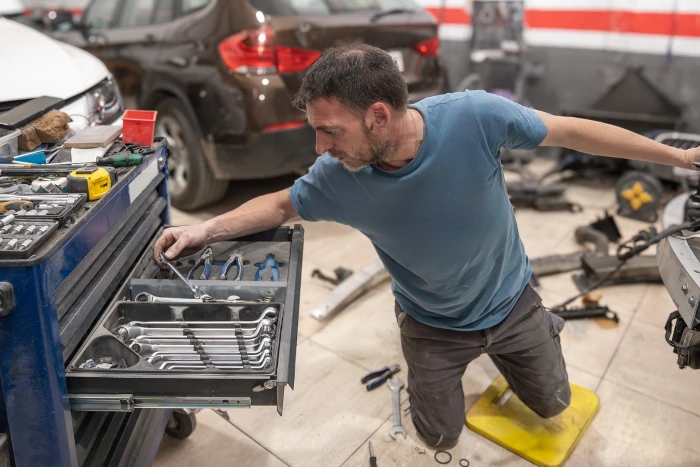
Ziplock Bags And Sharpies Are Your Friends
If you take a part off your vehicle or a donor parts vehicle, make sure you bag it up and clearly label it. This also applies to spares you buy. Ideally have some systematic storage solution in place and label the boxes or tubs you put the bags in. Otherwise, good luck getting everything back in the right place. Take photos and videos during the disassembly, especially if you do not have a workshop manual for the vehicle. For suspension, drivetrain and engine bolts where you don’t have torque specs. Use a torque wrench and record the settings as you disassemble.
Learn, Learn, Learn
As you begin your journey, find as many books, articles, internet pages, as you can. You could even join a local restoration club. Nobody becomes an expert overnight but the more you know about the cars, the higher chance you have for a successful outcome for your project. There are many excellent videos on YouTube covering all aspects of vehicle restoration.
Expect Delays
You might have a timeframe in mind for completing your project, but inevitably life happens. Don’t feel rushed or tempted to cut corners as you fall behind your initial schedule. Remember to enjoy the process, and simply appreciate the whole experience.
Enjoy Yourself
Don’t forget that a car project should be enjoyable.
We Make Storage Easy
Don’t forget us when its time to declutter your workspace or store the parts you are collecting. Our staff are storage experts and can recommend the amount of space you need. Don’t forget our flexible agreements allow you to upsize or downsize as required and rent weekly after the first month.
To work out how much space you need, ask our staff or check out our space calculator or 3D storage visualizer.




